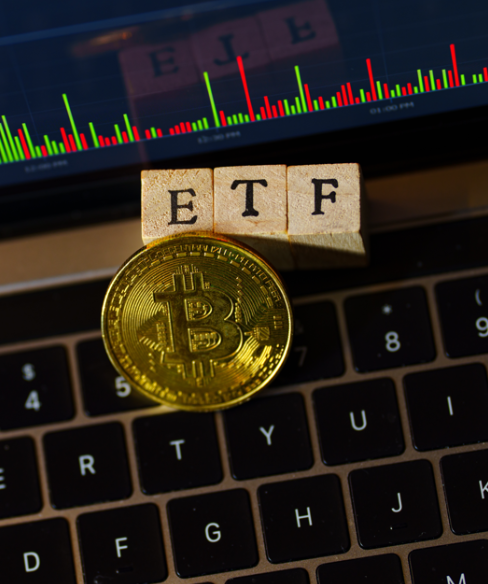Exploring Crypto ETFs: A New Gateway to Digital Asset Investment
- 82 Views
- admin
- 08/27/2024
- Cryptocurrency
The world of cryptocurrency continues to evolve, and one of the most intriguing developments for investors is the rise of crypto exchange-traded funds (ETFs). These financial instruments offer a straightforward way to gain exposure to digital assets—without the need to own or manage them directly. Whether you’re an experienced trader or a curious newcomer, understanding crypto ETFs can be key to navigating modern investment strategies.
Understanding ETFs in the Crypto Space
A cryptocurrency ETF, or Exchange-Traded Fund, is a financial product that tracks the value of digital assets such as Bitcoin or Ethereum. Instead of buying and storing these assets yourself, you can invest in an ETF that mirrors their performance. It’s a hands-off approach to crypto investing, designed for those who prefer the structure of traditional markets.
In essence, a crypto ETF lets you participate in the cryptocurrency market by purchasing shares in a fund that holds or tracks digital assets, much like stock-based ETFs.
Why Investors Choose Crypto ETFs
For many institutional and retail investors, entering the crypto market directly can be daunting. Regulatory uncertainties and the need for secure storage add layers of complexity. Crypto ETFs solve this by offering a regulated, more familiar investment route that reduces technical and legal barriers.
How Crypto ETFs Are Structured
Crypto ETFs operate in a manner similar to other ETFs, but with a few unique components. Here’s how the process generally unfolds:
Launch and Regulatory Approval
The process begins with the issuing company applying for approval from regulatory bodies, such as the U.S. Securities and Exchange Commission (SEC). Early investors provide initial capital, which is used to buy the assets the ETF will represent. Once approved, the fund is listed on an exchange, and shares become available to the public.
Asset Backing and Custody
In the case of a spot crypto ETF, the fund is backed by actual cryptocurrency holdings. For example, a Bitcoin ETF would hold real bitcoins in storage to support the value of its shares. Secure custody solutions—often managed by third-party firms or internal divisions—are crucial here, ensuring the safety of these underlying assets.
Some industry observers have expressed concerns about centralizing large amounts of crypto with single custodians. Future diversification in storage methods is expected as the market matures.
Price Mechanism and Market Dynamics
The pricing of a crypto ETF is closely tied to the market value of its underlying digital assets. Market makers continuously trade ETF shares, adjusting supply and demand to keep prices aligned with the asset’s current value.
Additionally, authorized participants—such as large financial institutions—manage share issuance and redemption. If demand for the ETF rises, these participants add more assets to the fund and issue new shares. If demand falls, they redeem shares and reduce holdings, helping to balance pricing and availability.
Categories of Cryptocurrency ETFs
Crypto ETFs come in various forms, tailored to different strategies and risk profiles:
- Futures-Based ETFs: These invest in cryptocurrency futures contracts, rather than the assets themselves.
- Spot ETFs: These are backed by physical cryptocurrency holdings, offering direct exposure.
- Multi-Asset ETFs: These track a basket of cryptocurrencies, providing diversified exposure.
- Blockchain ETFs: These invest in companies involved in blockchain technology, rather than cryptocurrencies directly.
Spotlight on Key ETFs
Bitcoin ETFs
After years of regulatory resistance, the SEC approved the first U.S. spot Bitcoin ETF in January 2024. This was a landmark event, with firms like BlackRock and Fidelity launching their own ETFs shortly after. The approval marked a significant shift, signaling growing acceptance of crypto within traditional finance.
Ethereum ETFs
Following Bitcoin’s lead, Ethereum-based ETFs received approval to begin trading in July 2024. Nine issuers, including Grayscale and BlackRock, entered the market. While Ethereum may be harder for some investors to grasp due to its technical differences from Bitcoin, its ETF presence strengthens its role in institutional portfolios.
Solana ETF Status
Applications for a Solana ETF have been submitted, but approval remains pending. Regulatory challenges include the absence of a futures market and the possibility that SOL might be classified as a security. A final decision is expected by 2025, depending on evolving regulations.
How to Start Investing in Crypto ETFs
Getting started is simple. First, open a brokerage account with a platform that supports ETF trading. After funding your account, search for the ticker symbol of your desired crypto ETF, choose how many shares to buy, and complete the transaction. Your ETF holdings will appear in your investment dashboard, allowing you to monitor performance over time.
Final Thoughts
Cryptocurrency ETFs are opening new doors for investors who want exposure to digital assets without directly owning them. Their structure combines the benefits of traditional financial products with the growth potential of the crypto market. As regulations evolve and more ETFs enter the space, these funds could become a foundational tool for modern investment portfolios.
Recent Posts
- How AI is Revolutionizing Architectural Design: A Look at Tools, Trends, and the Future
- Streamlining Cyber Risk Assessments Through Automation
- Understanding the Difference Between Blockchain and Distributed Ledger Technology
- Is Bitcoin Mining Still a Viable Venture in 2025?
- Exploring AI: Unveiling Possibilities, Challenges, and Future Implications


